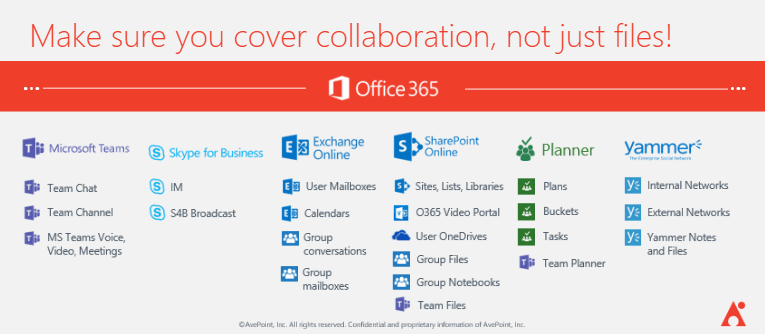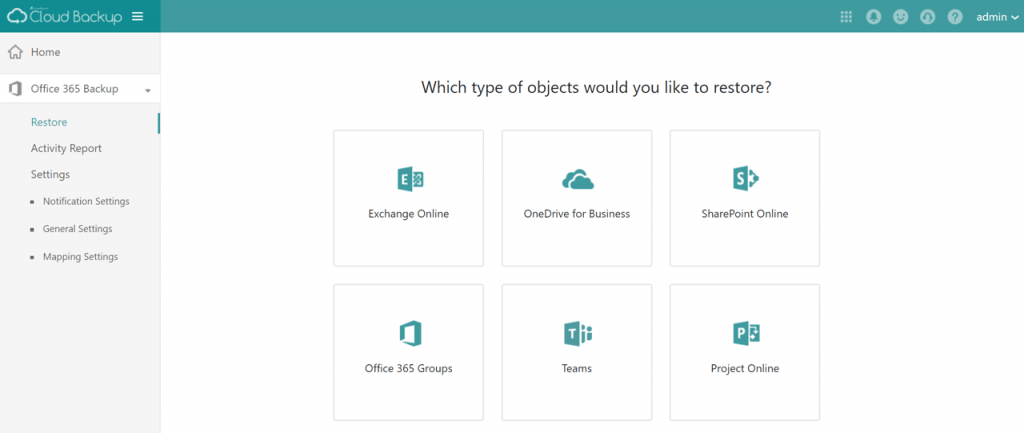Are you concerned for the safety of your data in the cloud? Learn about our cloud backup and recovery solutions for the Office 365 family here.
Managing enterprise backups has been a staple of IT for generations. The move to the cloud, and specifically Office 365, has forced us all to re-think how backups should be managed. When we talk about the five most common mistakes, we are speaking from experience!
As a company that had to transition from being best known for server-based backup products to cloud-based backups, we have gained experience that will help you manage this transition. Whether it be within our own organization or with customers, we consistently see these top five Office 365 backup mistakes.
1. Failing to Cover Your SaaS
When explaining to an organization why they need backup or recovery for cloud services, there’s almost always a false sense of ease you need to overcome. Many decisionmakers will make a statement like, “doesn’t Microsoft already offer backup services?” Understanding your responsibility as a customer and what Microsoft protects is of paramount importance when thinking about backing up all of your information. The chart below breaks down who is responsible for what.

The best summary of what service providers offer vs. what services you need to offer to your customers is provided by Naveen Chhabra at Forrester in the article, “Back Your SaaS Data – Because Most SaaS Providers Don’t.”
A great example of this: take a look at the “Files Restore” Microsoft offers to help users overcome accidental deletion. On the surface, this seems like a great end-user utility. However, you’re actually looking at a broader rollback tool than most users would expect:



Your users may not realize the impact of these file level rollbacks until you’ve potentially affected the adjacent work that you may have lost. Anytime you have to rely on a broad rollback (entire Sites, OneDrives, Mailboxes, etc.) you will face an end-user impact. It’s important to know what you are responsible for and for how long Microsoft will cover you out-of-the-box.
While you can leverage native versioning and retention to prevent loss of files – there are other scenarios that you are still responsible for including:
- Protecting information beyond the 93-day native recycle-bin settings
- Protecting documents and versions from potential ransomware or bad-actor scenarios
- Long-term preservation of content for users who have left the organization without having to place all content on legal hold
- Rollback of settings, configuration changes, or securities that users have altered
2. Not Understanding Office 365 Workloads
Office 365 is a living ecosystem, which means that the workspace is dynamic and constantly changing. Users view Office 365 as a multitude of applications to help them get their work done, whereas traditional backup tools attempt to reduce their work down to E-Mail, Calendar, and Files. When it comes to backup you must consider covering all of the collaboration material they generate across the Office 365 services, and not just the more obvious files you might be able to see on the surface. For example, a group that collaborates using Microsoft Teams will find they have:
- Profile information, channels, settings, ownership, permissions stored in Office 365 group settings
- Files, notebook items, sites, and announcements stored in SharePoint
- Person-to-person conversations stored in user mailboxes
- Team-based conversations stored in the common team mailbox
- Team planner boards
- Externally connected services

Assuming you made the decision that protecting content is your responsibility, you have to realize that your backup system needs to be prepared for the complexity of Office 365 backups. Correlation between the different core services offered by Microsoft is essential. If you delete a Team you need to ask yourself, “Will I get all this information back?” It is important to be mindful about scenarios like this and how your backup solutions will handle this!
3. Not Learning from Doomsday Preppers
It’s easy for us to consider only the edge-cases of protection for Office 365, but keep in mind that you might be facing scenarios where the entire data center may be offline. Understanding what your secondary options are for Office 365 is critical. Many of us are familiar with calculating the cost of an outage (which often factors into the RTO / RPO we offer back to the business). Owning your own data can be a crucial step to recovering from a loss with minimal downtime.

In addition to outages, you need to be prepare for the “Oh no…” moments that users occasionally encounter in Office 365. One classic example is the “I just inherited permissions on my site and lost all the unique permissions I had set up!”, or even worse “I just removed the permissions on my intranet site, and now I’m getting lots of access requests.” We’re familiar with this one from personal experience!

These seemingly small problems can seem like massive issues to your users. Your only option from Microsoft is to leverage their backup service and provide a rollback of the entire Office 365 to a previous point-in-time. Providing a recovery of security only is an essential feature of any service you may be considering!

4. Adding to the IT Burden
If a user calls in to troubleshoot lost content, it is IT’s responsibility to be able to answer whether or not they have that content, and to ensure all new content is being actively protected as it is created. Discovery of content is essential to solving the problem and delegating control will help mitigate those burdens. An example of a solution in this scenario would be a chatbot, like AvePoint’s Virtual Assistant (AVA). Using third-party tools like chatbot’s can help users look for lost content and limit support calls and mitigate some of IT’s workload.

5. Missing the True Cost of Service
There are a lot of different options when it comes to Office 365 backup. There are a lot of things to consider when it comes to selecting the appropriate vendor. Understanding the cost of service is important when it comes to make a decision and who is responsible for what. Here is an example of what those costs and responsibilities may look like:

We, as well as Forrester, highly recommend cloud-to-cloud backup as well when it comes to cost-effectiveness and making sure your Office 365 assets are secured and backed up properly. We highly recommend cloud-to-cloud backup because it is an elastic service that can scale up and down depending on your organizational needs.
Let’s recap!
When it comes to Office 365 backup, understanding your responsibility is of the utmost important for your businesses end users. Planning ahead in the event of a catastrophe is also crucial to ensure your business stays current and broad with Office 365. Don’t forget to automate when possible as well to help mitigate some of IT’s burden!
Want even more cloud backup tips? Click here to subscribe to our blog and stay in the loop.

